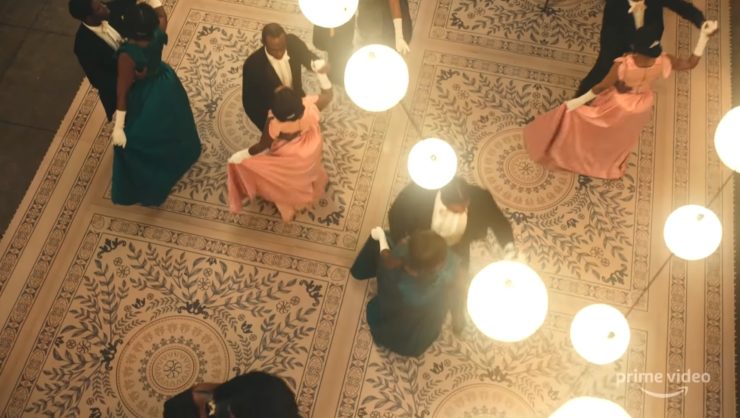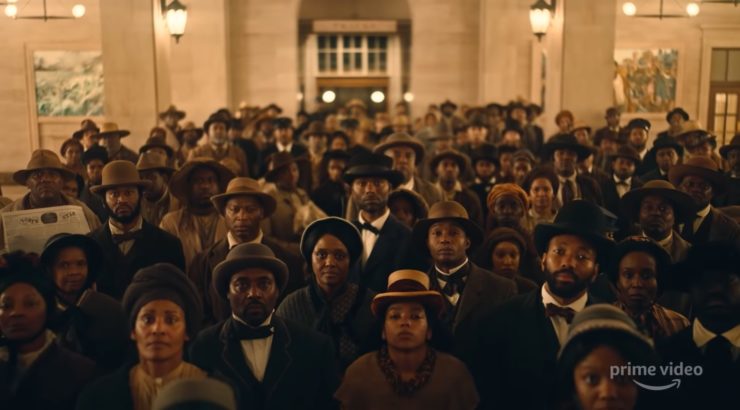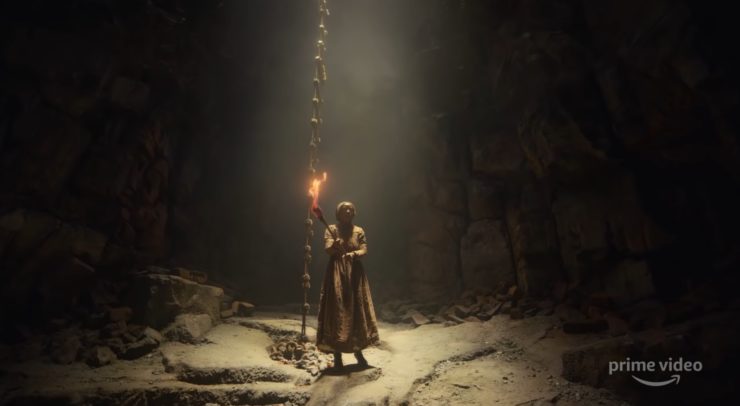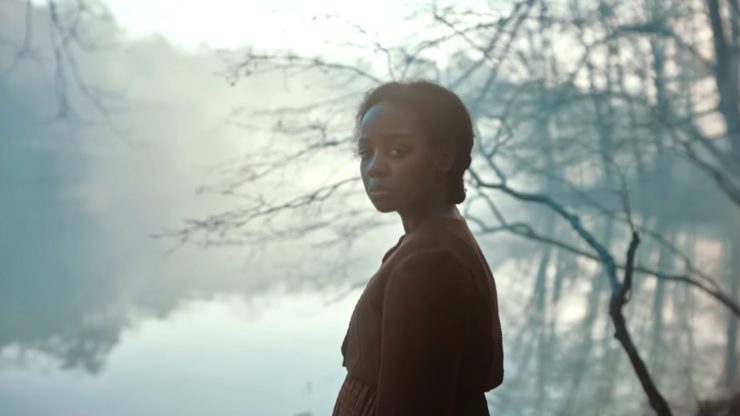Barry Jenkins’ new Amazon Prime miniseries, Underground Railroad, is a tour-de-force. At once gut-wrenching and awe-inspiring, I wrapped up the show convinced that we don’t even need television awards shows in 2022 because this cast and crew deserve all the accolades. This is one of those works of art that could be taught in film school for technical skills, acting school for craft, and high schools and colleges for history lessons. It is exquisite on every level.
[Some spoilers ahead]
The show is set in an alternate reality version of our world, sometime in the mid-1800s. In this world there is no talk of succession or civil war, but there are slave states and free states, as well as the Missouri Compromise mucking up things out west. The story begins in Georgia with Cora (Thuso Mbedu), a young woman enslaved on the Randall plantation: After the plantation is taken over by a man who delights in extensive cruelty, Cora flees with her friend Ceasar (Aaron Pierre). They make it to the underground railroad, here a literal train in underground tunnels, and are deposited in South Carolina.
At first everything feels wonderfully freeing. Cora and Ceasar wear nice clothes, learn to read and write, eat good food, and get free medical care. When they walk through town, they don’t have to step aside or bow obsequiously to white people. But soon enough the shiny veneer cracks to reveal something terrible seething underneath. South Carolina is leagues better than Georgia until suddenly it’s not. Theirs is a fake freedom, one where the chains are metaphorical rather than tangible. South Carolina is to Georgia what Jim Crow is to slavery.

Cora again jumps on the underground railway and makes her way north, this time just over the border to North Carolina. Where their southern neighbors choose to keep Black folks around for labor exploitation, North Carolinians have retreated to puritanism and purity. The entire state is a sundown town, and Black labor has been replaced by Irish indentured servants. The Irish think of themselves as white, while white Americans think of them as only a step or two above Black people.
Cora’s northern journey veers west, first to Tennessee and then, with the help of underground railroad conductor Royal (William Jackson Harper), to an all-Black community in Indiana. As others have pointed out, each site depicts a different era in Black American history. To paraphrase Dr. Martin Luther King, Jr., the arc of the moral universe may bend toward justice, but progress is not linear. Cora moves through Black codes and Jim Crow, Black exceptionalism and respectability politics, Black power and Black nationalism, assimilation and acculturation, oppression and resistance. Things for Cora get progressively better overall, but oftentimes they get worse first.
Throughout this odyssey, Cora is hunted by Arnold Ridgeway (Joel Edgerton), a slave catcher who failed to capture Cora’s mother Mabel (Sheila Atim) when she ran away years before. Ridgeway and his Black boy companion Homer (Chase Dillon) blaze a trail of carnage as they follow Cora through the countryside. Their collision is inevitable yet heartbreaking, and produces some of the best acting moments in a show chock full of powerhouse performances.
White supremacy is the rot at the center of everything. It pits not just white and Black people against each other but Black person against Black person, something Jenkins and Whitehead do not shy away from depicting. We see how our ancestors navigated and negotiated their relationships with whites, sometimes to the best of their abilities and other times at the expense of their kin. We see how toxic white supremacy is to white people, too. Time and time again we see white characters eagerly cut off their nose to spite their face, all to uphold the racial hierarchy.
Guardianship also features heavily throughout the series. Cora becomes a mother figure to three children while dealing with the trauma of being abandoned by her mother, who she believes left her behind to run away to a free life in the North. Another enslaved woman is forced to raise twin babies owned by another plantation after the death of her newborn. Mabel, the plantation midwife, tries to mother Polly and Cora and fails at both due to circumstances beyond her control.
In the South, white guardianship over Black bodies comes in two flavors: the white slaver or imperialist who thinks it’s his God-given right to conquer and subjugate the “lesser races,” and those who see themselves as a benevolent protector who can guide the “uncivilized” to at least a basic kind of enlightenment. We also see the fun house mirror version of Cora’s relationships with Black children through two white men. One strips his charge of her name and freedom, keeping her locked away supposedly for her safety but really for his own. The other trains an emancipated slave to see his skinfolk as creatures to be used and abused.
Neither Whitehead nor Jenkins show the audience much of the world beyond what Cora sees. We only get glimpses of five states, and each are so different as to feel more like nation states than parts of a unified whole. But because I’m a history nerd, I am extremely curious to know what the situation is like west of the Rockies. By the mid-19th century there were people from all over the world sailing toward Gold Mountain—as well as several hundred to several thousand enslaved Africans toiling in the gold fields. The Black characters in the show see California as a land of opportunity, just as their compatriots in the real world felt. Thousands of African Americans, free and enslaved, went West starting in the 1850s, and there was an intentional push, especially by freeborn East Coasters, to establish all-Black communities. California even had its own version of Valentine’s Farm, Allensworth, just north of Bakersfield.

For the Black characters headed to California, what would they find there in this alternate reality? How different or similar would it be to our world? Would it really be the haven they imagine it to be? That they even call it California instead of Alta California means that the US has achieved its dream of manifest destiny by winning the Mexican-American War. Knowing what I know about how the land was stolen from Indigenous Californians by Spanish and Mexican colonizers, then stolen from them by white Americans, I doubt the state will live up to their expectations.
Barry Jenkins’ Underground Railroad differs from Colson Whitehead’s version in ways major and minor. Jenkins invents characters whole cloth, expands and changes the backstories of some characters, adds two romance subplots, and spends most of the episodes lingering in the latter part of the novel. It has been years since I read the book, and even though I knew the general arc of the story, I appreciated the ways in which Jenkins managed to consistently surprise me. Not a single invention or alteration feels unnecessary or unwarranted.
Visually, Underground Railroad is absolutely stunning, and a good chunk of that is due to cinematographer James Laxton. Laxton also shot two of Jenkins’ other features, If Beale Street Could Talk and Moonlight. There are more than a few shots that take your breath away, not just scenes of violence and terror, but of beauty as well. I think my favorite is in the final episode where Cora and a traveling companion are standing beneath a tree, looking out at a landscape they’ve never seen before. The shot was unscripted; according to Jenkins, they were rolling and he had not yet called “action,” to start the scene. Those few seconds convey a world of emotions. Jenkins and Laxton use every tool in the cinematography book to excavate, excoriate, express.
Speaking of the acting, Mbedu is a relative unknown in the US, but I hope this is the first of many big ticket starring roles. In every episode she must expose Cora’s soul to the audience, and Mbedu does it so well, it feels real. It sounds trite to call her a revelation, but I’ve run out of words to describe how visceral her acting was. If we lived in a just world, she, Atim, Pierre, and Harper would have directors lined up at their doors, scripts in hand. Even actors we only see briefly—like Calvin Leon Smith as Jasper, Zsane Jhe as Lovey, Abigail Achiri as Polly, Peter De Jersey as John Valentine, Chukwudi Iwuji as Mingo, Irone Singleton as Mack, Deja Dee as Sybil, and Mychal-Bella Bowman as Grace—turn in career-making performances.

The average viewer doesn’t often notice good sound mixing or editing, but this show is one time you really should. Insects trill and drone and buzz, building a sense of unease and foreboding. Footsteps track on creaky floorboards or are silent as a predator on the hunt. The sound of clanging metal and jangling chains haunt Ridgeway and Cora like ghosts, popping up in expected and unexpected places to remind them and us that they can never escape their pasts.
Throughout the series, the show breaks the fourth wall by having Black characters stare down the camera. They dare the audience to not look away, to gaze upon the horrors inflicted upon Africans in America and the horrors inflicted by white people. This, to me, is one of the biggest differences between Underground Railroad and something like Them. It’s less about the amount of graphic violence and more about how it’s used. The first episode of Underground Railroad features a protracted scene of a Black man being burned alive after being whipped so badly his skin has been flayed from his chest, all while white people dine and dance as if his death is no more than an entertaining spectacle. Jenkins keeps the focus on the enslaved. We see through the dying man’s eyes and feel the gnawing fear and disgust of the enslaved at the white people who could so casually stoop to such acts. The man’s death conveys important plot information, but he himself is not a plot device. Jenkins asks us to witness our ancestors, those who were enslaved and those who did (or supported) the enslaving. The violence isn’t about running the audience through the wringer, but showing the truth of the people at the heart of that violence.
Each episode brings forth a well of intense emotions and experiences. For review purposes, I had to watch the entire show in two big sittings over a single weekend, but I highly recommend not binging. Spend some time between episodes to sit with your feelings and process what Barry Jenkins and Colson Whitehead are saying. This is a show where the message and context are just as important as the plot and visuals. Give yourself space to breathe.
Many of the conversations that take place in this show are intracommunity ones that non-Black people are watching as outsiders, much like the white rich Indianans standing at the back of the church as Valentine and Mingo debated the future of the farm. Because of this, non-Black people will not get every reference, historical or contemporary, or pick up on every nuance. No single review of the Underground Railroad could ever do the show justice. Dissertations could be written and still not cover every tiny yet crucial detail. I encourage you to read what other Black writers besides me have to say about Underground Railroad. And hey, maybe you’ll learn a thing or two.
I know many of us are tired of seeing our stories be limited to slavery and civil rights, but Underground Railroad is an exception you need to take. This is not trauma porn or brutality for brutality’s sake. Trust Barry Jenkins and Colson Whitehead to guide you through this with thought and care.
Alex Brown is a librarian by day, historian by night, author and writer by passion, and a queer Black person all the time. Keep up with them on Twitter, Instagram, and their blog.










